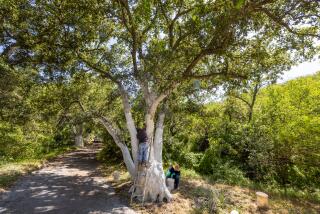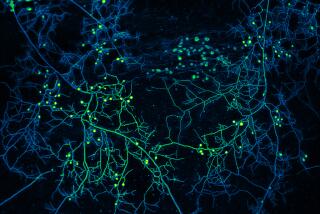Getting to Root of Rare Wood Fungus
A fungus is sprouting up around Orange County, snaking around stucco and brick to get to its daily meal--the wood in and around your home.
When the feast is over, once-solid walls and floors are left mushy enough to put a pinky finger through, and once-secure property owners are left scrambling to come up with the thousands of dollars needed to repair the damage.
“I feel like the guys from ‘X-Files’ are going to come check in. It’s like an alien invading,” said Carol Conover, whose Corona del Mar home has been infested by the fungus. And she is not alone.
In the last two decades, Meruliaporia incrassata--an orange-colored, mushroom-shaped fungus--has shown up with more frequency in houses from San Diego to Northern California. And because most homeowners, pest control inspectors and contractors are unfamiliar with the unusual growth commonly called poria, the fungus spreads untreated and unchecked through houses big and small, an equal-opportunity menace.
“It’s a rare fungus, but it’s as common here as anywhere in the world,” said UC Riverside plant pathology professor John Menge. “It’s also the most devastating wood-decay fungus of houses that we know of.”
It sounds like science fiction and looks like it too, but poria, like all decay fungi, is an organism that needs moisture to break down and utilize wood as a food source, according to forest product experts at UC Berkeley.
“The bad news about poria is that it’s hidden and it spreads fast, but once you find it, it can be controlled,” said Wayne Wilcox, a UC Berkeley forestry professor.
Unlike other decay fungi, which tend to destroy only a 6-inch area around a plumbing leak or wet window sill, poria has the capacity to begin in wet soil--usually under a newly installed patio, new landscaping or a room addition--then travel to dry wood by pumping water through a root-like system. Far from its original water source, the fungus continues to feed on the new supply of wood.
Donna Kingwell, a spokeswoman for the state’s Structural Pest Control Board, said the agency “is keenly aware of the potent problems of poria, especially in the southern part of the state.”
Conover had lived in her Corona del Mar home for 11 years when she first discovered her poria problem about three years ago. “I had a fungus on a window casing--they said it was dry rot. Then fifteen months later it was coming out of the same window again.”
Conover began finding clothes and shoes with the telltale orange markings around the house. She also saw poria in full bloom. “It was pretty much mushroom-like, orange and very, very wet. I said, ‘We haven’t had any rain since March. How can this be?’ ”
Before long, Conover said, she and her three children were spending hours at a time scraping away poria with putty knives. The fungus sprouted over the windows, behind the bathroom cabinet, inside the door frames, below the floor and inside the ceiling.
“It got scary when you realized one of the walls that the fungus could get to was a sheer wall,” she said. “My children understand that a sheer wall holds up the other wall in an earthquake.”
Scarce Information
The area attacked by poria is quickly obliterated, said David Taylor, technical director of the pest control company Antimite in Costa Mesa. “We had a Fullerton customer whose toilet just fell right through the floor,” Taylor said. “People get really worried when they see how the wood is destroyed. They kind of freak out on you. After all, their homes are their main investment.”
Often the financial frustrations are only the beginning. Finding professionals who are familiar with poria and insurance companies ready to compensate for poria losses can be nearly impossible.
Peter Zappas, a property manager in Laguna Beach whose floor was being devoured by poria, had to wait for a month and a half to meet Luis De La Cruz, a Van Nuys pest control specialist and, according to Wilcox at Berkeley, one of the most knowledgeable inspectors in California about the fungus. “I tried to fix it myself, but it came back again,” said Zappas, whose home now has a 2-foot moat circling his back porch as part of the poria removal process. “I have a hole outside. The wood is bad in some areas.”
“It’s real dangerous,” said Steve Soklos, owner and operator of Solo Termite Control Inc., based in Mission Viejo. “At this point it practically takes a specialist to identify and work with it, and there are just a handful of people that know how. Most everybody that I know of here in Orange County doesn’t want to go near this one because it’s such an aggressive fungus and the smallest strand can regrow.”
Kenneth Manesse, Solo’s general manager, has taken on the task of learning more about poria’s power. “As a general rule we’re seeing more of it,” Manesse said. “More cases are being reported, and people are getting educated about poria.”
For six months, Manesse has been observing the growth patterns of a poria sprig, which he clipped from an infected Laguna Beach house.
The fungus, contained in an aquarium, sits on Manesse’s desk at the Solo office. “I feel sorry for this piece of wood that’s sitting in there with it,” Manesse said. “It ate through it. The fungus has left it without any structure. It’s gone.”
A Long History
First reports of Meruliaporia incrassata destruction surfaced in 1913 in the southeastern United States, where forest products--the suspected origin of the fungus--abound. In California, scientists discovered the telltale spores on three coastal redwoods in 1924.
Infestations of poria are rare--only 15 cases were reported statewide by 1968, according to a U.S. Department of Agriculture study.
Poria experts believe that more recent increases in California can be traced to new building standards established after the oil crisis in the late 1970s. To conserve energy, houses have been built close to the ground, where the fungus has easy contact with wood. Newer homes also tend to have poor ventilation, Wilcox said, allowing poria to thrive.
Because the state does not require an inspection for poria when homes are bought or sold, or when they’re under construction, no state or city keeps accurate track of cases, said Al Garcia, who works for the Los Angeles Department of Building and Safety and is a spokeswoman for the state Structural Pest Control Board.
But De La Cruz said that in the last year alone, he has identified about 80 cases in California, and UC Riverside’s Menge said he expects a bad infestation this fall because of last winter’s heavy rains. “It takes awhile to get started after the rains.”
When poria does invade a house, it’s almost always catastrophic, said Mississippi State University wood technology professor Terry Amburgey. “The fungus will [infiltrate] a foundation--wood or concrete--and pretty soon the entire house goes,” Amburgey said.
Insurance Battles
Homeowners who decide to eradicate the fungus are hit with a one-two punch: First they’re told that the repairs will cost thousands of dollars, and then that their insurance policies may not cover them.
Since poria, a hidden problem that develops over time, is discovered long after the destruction has begun, most claims are rejected.
Joe Howard, a Sherman Oaks resident, fought his insurance company and won.
Howard discovered the telltale orange ooze growing at the intersection of the wall and floor in his daughter’s bedroom 2 1/2 years ago.
“After we stripped the walls away, we found the stuff everywhere,” he said. “It’s like a parasite or a vampire attached to the house.”
With an estimated cleanup cost of $15,000, Howard called his State Farm insurance agency, which turned down his claim.
After the Consumer Services Division of the California Department of Insurance refused to act on his behalf, Howard told State Farm he intended to pursue his claim further. The insurance company agreed to an arbitration hearing to settle the matter.
Howard won his case after proving to the judge that the poria infestation caused the collapse of his home. “I had to bring in a pamphlet put out by the [U.S. Department of Housing and Urban Development] that explains what [poria] is, just so the judge would understand the severity of it.”
State Farm spokesman Phil Supple said the insurance company still covers structures that collapse due to hidden decay but added that the definition of “collapse” is decided on a case-by-case basis.
In Corona del Mar, Carol Conover continues to have workers scrape away at all the poria they can find as she tries to persuade her insurance company to cover the cost of repairs. “The area behind the bathroom cabinet is just gone,” she said. “You touch it and it crumbles.”
Times staff writer Valerie Burgher contributed to this report.
(BEGIN TEXT OF INFOBOX / INFOGRAPHIC)
Managing the Fungus
People with mold and mildew allergies are advised to avoid contact with the material during cleanup. Inhalation of spores can lead to inflammatory reactions, such as chronic sinusitis and bronchitis.
Signs of Infestation
* Separation of baseboards from the floor.
* White threadlike membranes forming fan shapes under wallpaper or floor coverings.
* Swelling and crumbling of plaster or drywall.
* Mushroom-shaped fruit bodies on rotten wood around window sills, cupboards or the underside of flooring.
* Irregular vine-like roots branching in the soil and extending to foundations, framing or the subflooring.
Methods of Control
* Locate and remove the fungus’ source of water, usually near the point of greatest decay, and repair any plumbing leaks.
* Cut the roots, or rhizomorphs, and scrape fungus growths from the foundation.
* Remove contaminated soil from the property.
* Dry out all affected areas, from floor joists to ceilings.
* Replace decayed wood with pressure-treated lumber.
* Once the fungus is eradicated from a home, the property should be inspected by a poria expert once a year.
Information Resources
UC Berkeley’s Wayne Wilcox and pest control specialist Luis De La Cruz give periodic workshops for general contractors and pest control inspectors on the identification and treatment of Meruliaporia incrassata. For information, call the state Structural Pest Control Board, (916) 263-2540.
The UC Forest Products Laboratory in Berkeley has also set up a telephone number where people may leave their addresses to get information mailed to them about poria: (510) 215-4261.
Sources: U.S. Department of Agriculture, the U.S. Forest Service, the U.S. Department of Housing and Urban Development, and the California Department of Health Services






